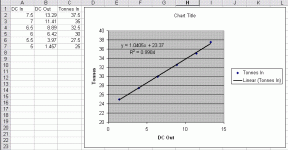Hi All,
I have come across a signal convertor unit, that converts a voltage to another. I did some checks on this with my dvm and came up with the following readings:
D.C. Signal In
7.5
7
6.5
6
5.5
5
D.C. Signal out
13.29
11.41
8.89
6.42
3.97
1.457
Tonnes In
37.5
35
32.5
30
27.5
25
Now I need Tonnes Out?
I can't seem to get my head around the maths on this one? However I think this unit has been used to increase the scale over a range of weight (25 to 37t) to give more accuracy, in this range. After this unit the input goes directly to a PLC input.
What I would like to do is convert the existing weigh signal, 0 to 50t to operate over this range. Using the mA loop between 25 and 37t as described above. However this is not a simple ratio matter, as you know with different slopes on each signal, the ratio varies over time/emptying and is not fixed.
Please help if you can offer anything?
Thanks as you say here (in advance).
Ben
I have come across a signal convertor unit, that converts a voltage to another. I did some checks on this with my dvm and came up with the following readings:
D.C. Signal In
7.5
7
6.5
6
5.5
5
D.C. Signal out
13.29
11.41
8.89
6.42
3.97
1.457
Tonnes In
37.5
35
32.5
30
27.5
25
Now I need Tonnes Out?
I can't seem to get my head around the maths on this one? However I think this unit has been used to increase the scale over a range of weight (25 to 37t) to give more accuracy, in this range. After this unit the input goes directly to a PLC input.
What I would like to do is convert the existing weigh signal, 0 to 50t to operate over this range. Using the mA loop between 25 and 37t as described above. However this is not a simple ratio matter, as you know with different slopes on each signal, the ratio varies over time/emptying and is not fixed.
Please help if you can offer anything?
Thanks as you say here (in advance).
Ben






